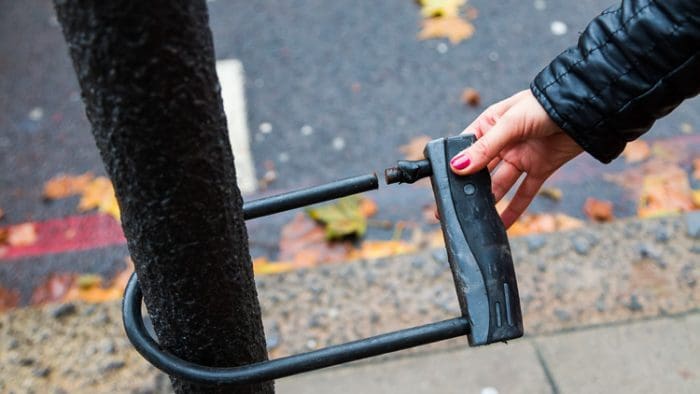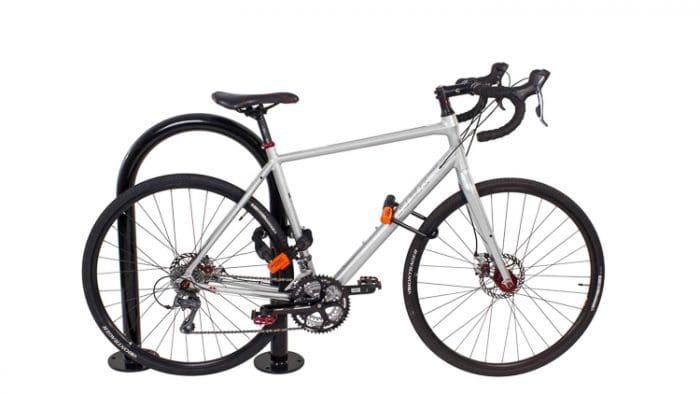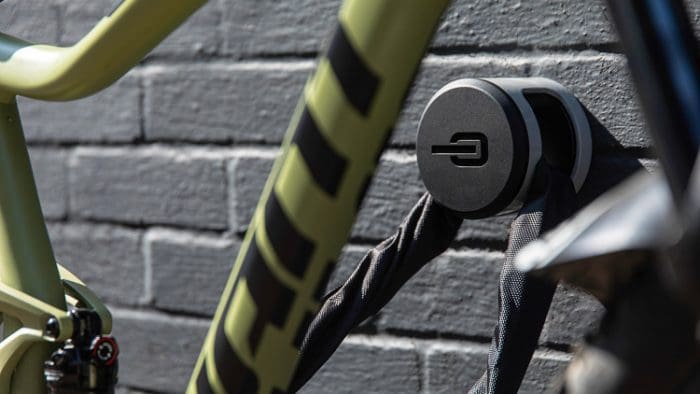Bicycle theft has been a problem for as long as bicycles have existed, however, the last two years have shown an increase in incidences. The simple explanation for this uptick in bike theft is that there aren’t enough bikes and bike parts to meet the current demand. If you’ve ever lost a bike to theft, then you’ve experienced the shock and heartbreak, perhaps even feelings of violation, that immediately follow. If you’ve never experienced the loss of a bike due to theft, consider yourself fortunate and also consider increasing your current safeguards to avoid the stress associated with becoming a statistic.
How common is bike theft?
About 190,000 bicycle thefts are reported each year in the United States, a statistic that in itself is shocking. However, when the number of unreported thefts (estimated to be 152,000 additional bikes) is factored into the equation, the rate at which bikes go missing really is staggering: one bike is stolen every 1.54 minutes. BikeIndex.org, a National registry of bicycles, reported over 96,000 bicycles marked on their site as stolen in 2020, a 24% increase from 2019.
Why is bicycle theft becoming more common?
Bicycle theft happens at such high rates in the US because bicycle bandits see the reward as being far greater than the risk; stealing bikes is easy and thieves are rarely caught. However, supply chain issues predominantly caused by pandemic-related factors, have compounded the situation. This deficit in supply has also driven up the prices of bikes and bike parts, new and used.
No products found.
Statistical trends are also showing that geographic location might play a role in the prevalence of bike theft. There are several theft hotspot cities around the US that have seen an increase of reported bicycle thefts that are too significant to ignore: reported thefts in Denver, Colorado increased by 26%, New York saw a 30% spike over the last six months of 2020 (when compared to 2019), and Seattle, Washington saw a staggering 54% rise! You don’t have to live in one of these cities to fall victim to bike thieves.
It’s so easy to get away with it
One major contributing factor to the increase in bike theft is that it’s just so easy for criminals to get away with it. A bicycle’s very nature makes it an easy target for theft: they are lightweight and simple to disassemble, making them easy to transport. The fact that they can be ridden away means they even offer thieves a quick getaway. Bike theft also isn’t high up on the priority list for law enforcement, so the likelihood of getting caught is also very low.
Many people are under the impression that “any lock will do” or that “a lock is a lock” and end up with inadequate security that isn’t able to withstand the skill and cunning of most criminals. In other cases, ample locks are used—but they’re used incorrectly. Some cyclists even resort to GPS tracking devices so small that they can be hidden on or in the bike. Unfortunately, they do little to deter thieves because many have learned how to locate and remove them.
Thieves are coming up with new ways to steal bikes. One new scam involves the would-be thief locking your bike to a decoy bike to buy more time to complete the crime. Most bike owners leave their bike with the intention of getting it later, but upon returning, discover both the mystery lock and their bike missing. Some thieves who are short on time might even go as far as to cut through a bike frame. While it doesn’t sound logical, there’s nothing that prevents anyone from stripping a bike down and selling it for parts—especially when a single bike part can bring upwards of $500.
Hotspots for theft
Whether you’re leaving your bike at home, in public, or even in your vehicle, it’s always at risk of being stolen. In fact, when it comes to where bikes are physically being stolen from, a disturbing new reality has emerged: there’s an increasing number of bicycles being stolen from residential locations, either from garages or from inside the home.
Many garage doors are left open, especially on weekends, with everything inside the garage on display and subject to a grab-and-run theft. Even closed garage doors are easily breached with a pry bar to access the top of the door, and a coat hanger to hook the emergency door opener cord. For many who live in homes with attached garages, the chances of a thief having access to the home itself rises.
Thieves are opportunists, so they often stake out places that keep bike owners indoors and out of sight long enough for a lock to be cut and the bike taken. Parking areas of grocery and department stores, restaurants, movie theaters, sports grounds, and even schools are popular places to pilfer a bike. Resist the temptation to lock up in the same place every time you go to the gym or your favorite coffee shop; thieves pay attention to these kinds of patterns to better help them decide when and how to make off with a bike. It’s best to change things up every now and then.
Which Bicycles are Stolen the Most?
Many people think that there must be a particular bike that is especially targeted, but the reality is that there isn’t. Thieves generally go for whatever is an easy steal, so bikes with no or minimal security are most at risk. Thieves are familiarizing themselves with high end bike manufacturers to better help identify which bikes in a sea of many are most worth their time. It’s also no secret that e-bikes cost a pretty penny, with the cost of a lithium-ion battery for a mid-range e-bike alone averaging $600.
How often are stolen bikes recovered?
Shockingly, fewer than five percent of stolen bikes make it back to their owners. Stolen bikes are sold within days, sometimes hours. Once a bike has left the hands of the thief, it becomes nearly impossible to track. Even when bikes are recovered, it’s difficult to identify or confirm the owner because many bike owners don’t keep a record of the serial number, adding to the astronomical estimate of unreported bike thefts.
No products found.
Lock basics
When it comes to securing your bike, having an “it’s good enough” attitude isn’t going to cut it. If you want to walk away from your bike with the peace of mind that your bike is protected, you must invest in high-quality, heavy-duty locks that are easy to use and hard to break. Depending on the material, configuration, and durability of the lock, expect to spend from $30 to $300.
The kind of lock you need will depend on where your bike will be left. Bicycles left for extended periods of time in busy cities or places known for higher rates of theft should always be equipped with maximum security, which often implies usage of several locks, to better fend off criminals looking for a quick score.
Criminals use all kinds of tools to accomplish a hustle. The junkiest locks can be broken by simply jerking a bike back and forth several times with good force. Hammers can be used to smash locks and cable cutters can be used to cut through the most popular cable locks. Most mid-weight U-locks can be weakened by spraying them with canned liquid nitrogen and broken with a few hammer blows. Hacksaws, crowbars, and bolt cutters are also commonly used because they’re easy to find, use, and conceal. However, criminals who are serious about making off with your bike are also packing hydraulic bottle jacks and power tools. When inserted into the space of a larger-sized U-lock at just the right angle, the bottle jack can exert enough force to break the most secure of locks. Angle grinders, handheld power tools equipped with diamond tile cutting discs, are small enough to be concealed when carried, are available as battery operated, and are powerful enough to cut through just about any lock in minutes.
Whether your bike is conventional or electric, the same rules apply; when it comes to bike security, your best bet is a hardened steel chain (12mm link diameter or greater) paired with a massive hardened steel lock. A smaller-sized U-lock with a flat key is also a good alternative. It’s best to stay away from round key locks, as they are easier to break. Cable locks are commonly used, but the truth is that they offer minimal security because they can be easily cut with tools that are readily available at any hardware store or online, so it’s best to steer clear of them. Instead, opt for the more durable options.
Those who aren’t especially keen on carrying multiple hefty locks might want to make bicycle components much harder to remove by replacing wheel skewers, seatpost and headset locks with specifically designed replacements from Pinhead Locks or Hexlox. These security devices make it impossible to remove any of the protected parts without a specialized key. Once you make the components difficult to remove, a single heavy-duty lock might become sufficient.
There are also some specialty locks and devices on the market that, when tampered with, sound a noisy alarm or release food-grade non-lethal chemicals similar to pepper spray. Others are made from layered materials that result in a lengthy, tedious bolt-cutting experience that most thieves wouldn’t bother with.
How to properly lock up your bike
There’s a correct and an incorrect way to secure a bicycle. The correct technique results in your bike being where you last locked it and the incorrect way leaves you bikeless. Whenever you have to leave your bike in a public place, it’s best to secure your bike in a location that’s busy with heavy foot traffic and under CCTV surveillance.
Secure your bike by running the first lock through your bike frame, the front wheel, and around the anchored object. If you lock up by the wheel alone, you’ll come back to a single wheel with no bike because how you physically secure your bike matters. It’s imperative that the lock fits snugly, otherwise you risk giving thieves the extra space they need to leverage the lock. A second lock should be used to secure the back wheel to the frame. Be sure to keep any locks away from the ground and as difficult to access as possible to deter someone from taking a hammer to it and smashing it to bits.
Before walking away, be sure to remove the saddle, lights, computer, and any other easily removable accessories or components. Remember that the security skewers and component locks can be used if you prefer leaving certain items on your bike, but bike computers, saddlebags, and other accessories remain at risk.
How to lock your bike to a bike rack
Not all bike racks are created equal. Before you entrust the safety of your steed to a rack, inspect it for possible vulnerabilities: make sure it’s cemented into the ground and is sturdy. Thieves are known for cutting through some of the flimsier bike racks, so make sure the bike rack in question isn’t one of those.
When locking your bike to a bike rack, choose a location in the middle of the rack, surrounded by other bikes that are easier to access than yours—not at the ends. There’s a good chance that a thief will encounter a poorly locked bike before seeing yours and simply make off with that one. In the event that they want your bike, it’s unlikely that they’ll have much success if it’s surrounded by other bikes and has a lock that is nearly impossible to access—particularly if there are other cyclists coming and going. The idea is to make stealing your bike as inconvenient and difficult as possible to those scoping out their next score.
No products found.
In a private garage
If you own a property with a garage, then you’re in a unique situation because you have the authority to install whatever security hardware you’d like. Most bikes that are stolen from garages are taken when the door is left open, but it’s not uncommon for thieves to break into a garage. Many homeowners have motion-activated lights and alarms in place, but these measures usually do very little to deter a determined thief. Consider installing floor anchors that can be drilled and bolted into the garage floor or walls to better secure bikes and to prevent grab-and-run bicycle thefts. Be diligent about locking up the bike when it’s in the garage; a heavy-duty chain wrapped through a floor or a wall anchor or even house pipe is enough to deter most thieves. Throwing a tarp over your bike for good measure is also suggested, as it is less likely for theft to occur if a target for theft is never seen.
On a balcony or deck
While it’s not recommended that bikes be left on outdoor balconies and decks, in the absence of a garage, sometimes it’s the only viable option. At minimum, you should be using a heavy chain to secure the bicycle to a railing, but using additional locks or chains to secure the wheels wouldn’t hurt. Keep in mind that bikes should be outside for as short of a period as possible to avoid the elements. Sunny, humid summers can fade plastic and make it brittle, dry out rubber and consequently make tires unsafe, and cause bolts and other metal pieces to corrode.
In public garages
The risk of theft goes up when bikes are left in public garages. Thieves prefer working in places where there are fewer onlookers and potential witnesses, so look for options that are bustling with people and under CCTV surveillance. Try to avoid leaving your bike for prolonged periods of time—especially in places where you would be expected to be away for several hours. If a thief sees you walking into a movie theater or shopping mall, they instantly know that they have more than enough time to not only steal your bike but to steal the bikes of several other moviegoers, too. One last thing to make sure of is that your bike’s location doesn’t become a hindrance to others; there’s nothing to stop an angry individual from damaging your bike simply because it was “in the way.”
On public streets, including outdoor parking areas
Like public garages, locking up on a public street or in outdoor parking areas puts your bike at greater risk of being taken, so it’s recommended that you secure it in a location where there are other bicycles already locked up. If you secure your bike in the same area more than once a week or for prolonged periods, try breaking the pattern and moving it around a bit—thieves will notice a nice bicycle that is repeatedly being left in the same place. Avoid securing your bike to signs and utility poles, since by doing so you’re likely to violate a local ordinance and run the risk of being ticketed or even towed.
In or on your motor vehicle
It’s never recommended that you leave your bike in or on your car overnight, but if it’s your only option, then make sure you do it right. You want to make it very clear to someone considering theft that this will be no easy feat. It’s best to keep a chain, lock, and the key in the car so it’s always readily available when you need it.
If your bike is being left on a car bike rack, use a sleeved chain to secure the bike to the rack or tow hitch by feeding it through the openings where safety chains would normally attach. If your rack has a built-in lock, don’t confide in it alone. Instead, couple it with the recommended sleeved chain.
Bikes left inside vehicles should be secured with a sleeved chain that runs through the bike frame and loops through one of the grab handles. Whether or not your bike will need any disassembling will depend on the size of your bike and the interior space of your motor vehicle, but removing the wheels is standard practice in most cases. Interior bike racks are designed to be mounted to the floor of your car and are available to accommodate most station wagons, hatchbacks, SUVs, and pickup truck beds.
Bicycle insurance
With bicycle theft on the rise, protecting your bike is more important than ever. By correctly using the most resilient of locks and being consciously aware of how and where you lock up, you greatly increase the chances of your bicycle remaining yours. For additional peace of mind, consider bicycle insurance to cover the unexpected. Velosurance was created by fellow cyclists to cover just about anything that can happen to a bike, including theft. Visit Velosurance to quote and purchase insurance for your bicycle in less than two minutes.
Regardless of where it’s being stored or parked, always keep your bike secured using only chains and locks proven to be effective. Choose carefully when selecting a lock and give special consideration to industry leaders in bicycle security—they’re reputable for a reason. Also, be sure that you know how to use the lock and that you’re using it correctly. The only thing worse than leaving a bike unsecured is leaving one secured with an improperly used lock. When the best of security measures have been defeated, count on Velosurance to get you back in the saddle as soon as possible.
No products found.














